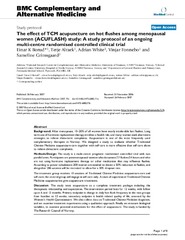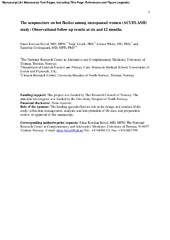| dc.contributor.advisor | Grimsgaard, Sameline | |
| dc.contributor.advisor | Alræk, Terje | |
| dc.contributor.author | Borud, Einar Kristian | |
| dc.date.accessioned | 2010-04-06T13:01:20Z | |
| dc.date.available | 2010-04-06T13:01:20Z | |
| dc.date.issued | 2010-04-16 | |
| dc.description.abstract | Introduction. Hot flashes and night sweats are the most prevalent symptoms in menopause. Hormone therapy with oestrogen is considered the most effective treatment. However, recent research show that long term use of oestrogen increases the risk of serious adverse effects, and women and their health care providers are looking for alternatives. Acupuncture is one of the most frequently used complementary therapies in Norway, and is considered safe in the hands of competent practitioners. Previous data on acupuncture treatment for hot flashes were
insufficient to draw any conclusions on the effect, but sufficient to justify further research. Acupuncture affects beta-endorphin activity in the central nervous system, and may thus also affect the calcitonin gene-related peptide (CGRP) excretion. CGRP is a potent vasodilator and stimulator of cholinergic sweat glands, and has been suggested as a mediator of hot flashes
and sweating in postmenopausal women. The Women‟s Health Questionnaire (WHQ) is a
health-related quality of life questionnaire, designed specifically to study possible changes that occur during menopause.
<br>Aims. We wanted to estimate the effectiveness of acupuncture in practice. Thus, our objective was to assess the effectiveness of a policy of use of traditional Chinese medicine (TCM)
acupuncture plus self-care on hot flash frequency in postmenopausal women, compared with a policy of use of self-care alone. The effects on hot flash intensity (0-10 scale) and sleep and on health-related quality of life as measured by the Women‟s Health Questionnaire (WHQ) were also assessed, as were the changes in urine excretion of CGRP. Secondary research questions were: “do TCM diagnoses predict the overall treatment response”, and “are patients with different TCM diagnoses likely to experience a differential response in their symptoms”?
The Norwegian version of the WHQ had not been validated, and the participants in the
Acuflash study reported more vasomotor symptoms than participants in prior studies of the WHQ. Therefore, it was necessary to evaluate the psychometric properties of the instrument.
<br>Materials and methods. The study was a multicenter, pragmatic, randomized, controlled trial with two parallel arms. Participants were postmenopausal women experiencing on average seven or more hot flashes per 24 hours during seven consecutive days. The acupuncture group
received ten individualized TCM acupuncture treatment sessions after initial TCM diagnosis, the control group received advice on self-care only. Frequency and severity (0-10 scale) of hot flashes and hours of sleep per night were registered in a diary. Urine excretion of calcitonin gene-related peptide (CGRP) was assessed at baseline and after 12 weeks. Primary endpoint was change in mean hot flash frequency from baseline to 12 weeks. Secondary endpoint was change in health related quality of life measured by the Women‟s Health Questionnaire (WHQ). Primary and secondary endpoints were also assessed at six and 12 months after study
start. The acupuncturists recorded TCM diagnoses and acupuncture points for each treatment session. Treatment reactions and adverse events were also recorded. The evaluation of the WHQ was performed by examining the factor structure of the Norwegian version, assessing the internal consistency reliability and floor- and ceiling effects, and by exploring the
construct validity of the instrument by comparing the WHQ to instruments measuring related constructs.
<br>Results. Hot flash frequency decreased by 5.8 per 24 hours in the acupuncture group (n = 134) and 3.7 per 24 hours in the control group (n=133), a difference of 2.1, p < 0.001. Hot flash intensity decreased by 3.2 units in the acupuncture group and 1.8 units in the control group, a difference of 1.4, p < 0.001. The acupuncture group experienced statistically significant improvements in the vasomotor, sleep and somatic symptoms dimensions of the Women‟s Health Questionnaire, compared with the control group. Urine CGRP excretion remained unchanged from baseline to week 12. We did not find statistically significant differences between the study groups regarding primary and secondary endpoint at six and 12 months after study start. Fifty percent of the participants in the acupuncture group were diagnosed with Kidney Yin Xu as their primary TCM syndrome diagnosis. No statistically significant differences were demonstrated between the syndrome groups regarding the distribution of responders and non-responders, nor regarding the changes in health-related
quality of life scores. A core of common acupuncture points (SP6, HT6, KI7, KI6, CV4, LU7, LI4, and LR3) were used in all the syndromes and in addition multiple idiosyncratic points. Core point selection and frequency of use did not differ between responders and nonresponders. No serious adverse events were reported. Some deficiencies in the WHQ questionnaire were observed when applied to the present sample, including an unclear factor structure, low alpha values for some dimensions, and a strong floor effect in the vasomotor symptoms dimension.
<br>Conclusions. Use of TCM acupuncture in addition to self care can contribute to a quicker reduction of hot flash frequency and increase in health related quality of life among postmenopausal women, but probably has no long term effects. Other factors than the TCM syndrome diagnoses and the point selection may be of importance regarding the outcome of the treatment. When evaluating the psychometric properties of the WHQ, the total scale score appeared reliable. However, care should be taken when interpreting some of the subscales when the instrument is applied on women with a high frequency of hot flashes. | en |
| dc.description.abstract | Kan tradisjonell kinesisk akupunktur i tillegg til egenomsorg redusere frekvens og intensitet av hetetokter i overgangsalderen, sammenlignet med kun egenomsorg?
<br>Hetetokter og nattsvette er de vanligste symptomene forbundet med overgangsalderen hos kvinner, og mange er mye plaget. Hormonbehandling med østrogen er den mest effektive behandlingen for disse plagene, men nyere studier har vist at hormonterapi kan være forbundet med alvorlige bivirkninger. Mange kvinner og leger ser etter alternativer. Akupunktur er en av de mest brukte alternative behandlingsformene i Norge. Tidligere forskning på effekten av akupunktur på hetetokter i overgangsalderen var ikke tilstrekkelig til å dra noen konklusjoner, men interessant nok til å rettferdiggjøre videre forskning. Vi ønsket å evaluere effekten av akupunkturbehandling og egenomsorg, sammenliknet med kun egenomsorg, på frekvens og intensitet av hetetokter og på helserelatert livskvalitet hos kvinner i overgangsalderen.
<br>ACUFLASH - studien var en pragmatisk, multisenter, randomisert, kontrollert studie med to grupper deltakere. Deltakerne var kvinner i overgangsalderen med i gjennomsnitt minst syv hetetokter i døgnet over en periode på syv påfølgende dager. Kvinnene i akupunkturgruppa (n=134) fikk 10 akupunkturbehandlinger i løpet av 10 uker i tillegg til egenomsorg, og kvinnene i kontrollgruppa (n=133) fikk kun egenomsorg. Frekvensen og intensiteten (0-10 skala) av hetetokter ble registrert i en dagbok. Helserelatert livskvalitet ble målt med spørreskjemaet ”Spørreskjema om helse for kvinner” (Women’s Health Questionnaire – WHQ).
<br>Etter 12 uker var hetetoktfrekvensen redusert med 5,8 hetetokter pr. døgn i akupunkturgruppa og 3,7 hetetokter pr. døgn i kontrollgruppa, en statistisk signifikant forskjell på 2,1 hetetokter pr. døgn. Reduksjonen i intensitet og økningen i livskvalitet var også signifikant større i akupunkturgruppa etter 12 uker. Seks og 12 måneder etter studiestart var det ingen forskjell mellom gruppene vedrørende hetetokter eller livskvalitet.
<br>Vi konkluderte med at akupunkturbehandling i tillegg til egenbehandling kan bidra til en raskere reduksjon av hetetokter og bedring av helserelatert livskvalitet hos kvinner i overgangsalderen, men at behandlingen sannsynligvis ikke har noen langtidseffekt. | en |
| dc.description | Papers 1, 2 and 3 of the thesis are not available in Munin due to publishers' restrictions:
<br>1. Borud EK, Alraek T, White A, Fonnebo V, Eggen AE, Hammar M, Astrand LL, Theodorsson E, Grimsgaard S: «The Acupuncture on Hot Flushes Among Menopausal Women (ACUFLASH) study, a randomized controlled trial», Menopause 2009, 16(3):484-493 (Lippincott). Available at <a href=http://dx.doi.org/10.1097/gme.0b013e31818c02ad>http://dx.doi.org/10.1097/gme.0b013e31818c02ad</a>
<br>2. Borud EK, Alraek T, White A, Grimsgaard S: «The acupuncture treatment
for postmenopausal hot flushes (Acuflash) study: traditional Chinese medicine diagnoses and acupuncture points used, and their relation to the treatment response», Acupuncture in Medicine 2009, 27;101-108 (British Medical Acupuncture Society).
Available at <a href=http://dx.doi.org/10.1136/aim.2009.000612>http://dx.doi.org/10.1136/aim.2009.000612</a>
<br>3. Borud EK, Martinussen M, Eggen AE, Grimsgaard S: «The Women's Health
Questionnaire (WHQ): a psychometric evaluation of the 36-item Norwegian
version», Scandinavian journal of psychology 2009, 50: 183-189 (Wiley-Blackwell). Available at <a href=http://dx.doi.org/10.1111/j.1467-9450.2008.00701.x>http://dx.doi.org/10.1111/j.1467-9450.2008.00701.x</a> | en |
| dc.format.extent | 2931129 bytes | |
| dc.format.extent | 260104 bytes | |
| dc.format.mimetype | application/pdf | |
| dc.format.mimetype | application/pdf | |
| dc.identifier.uri | https://hdl.handle.net/10037/2449 | |
| dc.identifier.urn | URN:NBN:no-uit_munin_2199 | |
| dc.language.iso | eng | en |
| dc.publisher | Universitetet i Tromsø | en |
| dc.publisher | University of Tromsø | en |
| dc.rights.accessRights | openAccess | |
| dc.rights.holder | Copyright 2010 The Author(s) | |
| dc.rights.uri | https://creativecommons.org/licenses/by-nc-sa/3.0 | en_US |
| dc.rights | Attribution-NonCommercial-ShareAlike 3.0 Unported (CC BY-NC-SA 3.0) | en_US |
| dc.subject | VDP::Medisinske fag: 700::Klinisk medisinske fag: 750::Gynekologi og obstetrikk: 756 | en |
| dc.subject | VDP::Medical disciplines: 700::Clinical medical disciplines: 750::Gynecology and obstetrics: 756 | en |
| dc.title | The ACUFLASH study. Acupuncture treatment for
postmenopausal hot flashes : can traditional Chinese acupuncture in addition to self-care reduce hot flash frequency and intensity,
compared with self-care alone? | en |
| dc.type | Doctoral thesis | en |
| dc.type | Doktorgradsavhandling | en |


 English
English norsk
norsk


